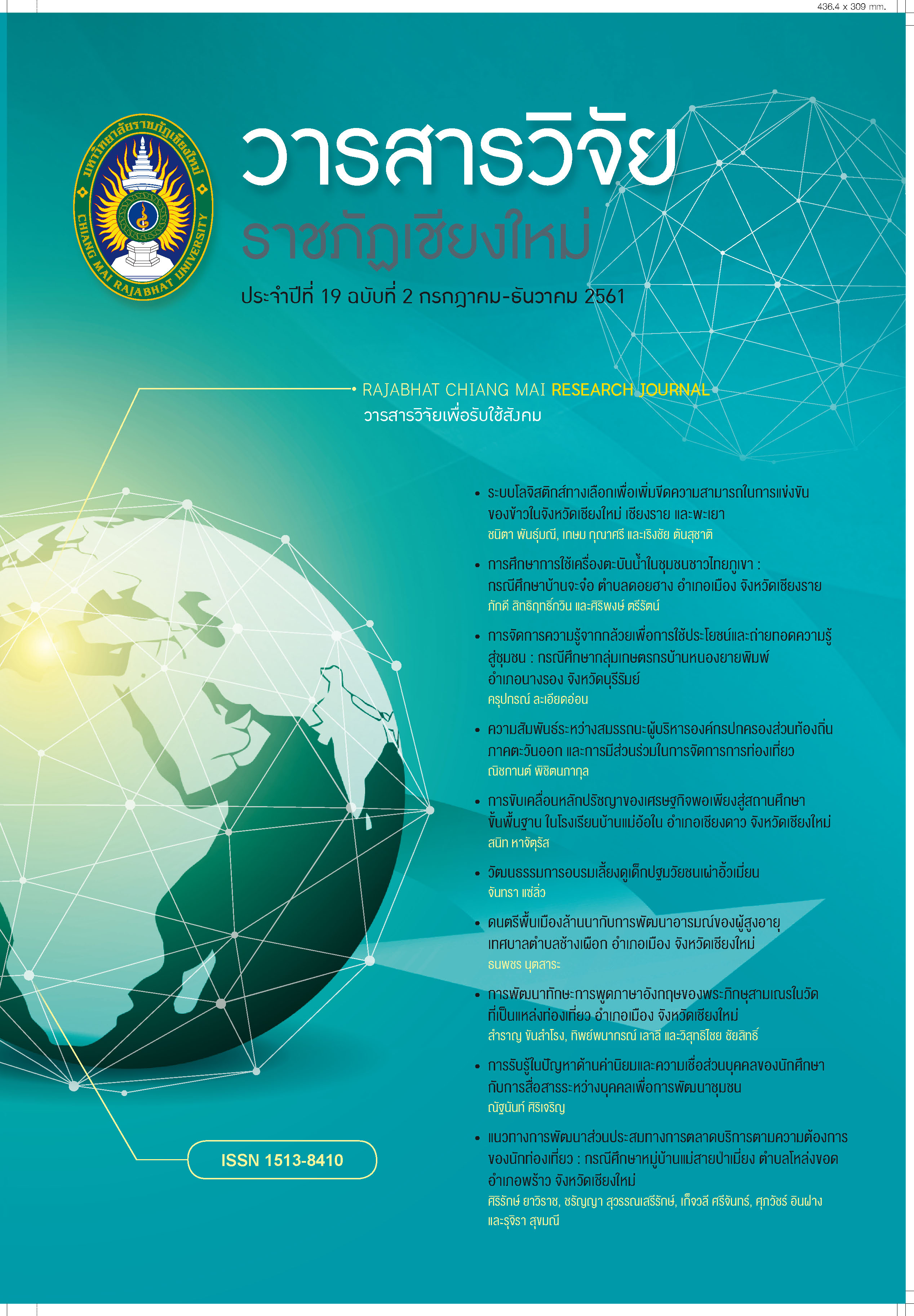The Hospitality Marketing Mix development guidelines towards Tourists needs : Mae Sai Pa Meing Village, Long Khod Sub-district, Prao District, Chiang Mai Province
DOI:
https://doi.org/10.14456/rcmrj.2018.149449Keywords:
Hospitality Marketing Mix, Tourists’ needs, Mae Sai Pa MiengAbstract
This research aimed to study the development hospitality marketing mix for the needs of tourists in Mae Sai Pa Meing, Long Khod Sub-district ,Prao District, Chiang Mai Province. The qualitative data were collected by group interview from 10 samples . The male samples were 3 and female samples were 7. The experimental was the travel program for 2 days 1 night.
The samples were divided into 2 groups: 1) The group will return to the place and 2) The group is uncertain to return to the place or will not come back to the place . The main factors which make the samples return to the place are people. They shared the same opinion about the friendliness and helpfulness of people. The other factors are beautiful products, the abundance of nature ,good culture, the traditional way of living and physical presentation which is clean. It is an important selling point if it has been updated to be more convenient and safety. In addition, standardized processes, fast, communication and convenient distribution channels will help to promote Mae Sai Pa Meing to be well known more quickly.
Downloads
References
2. ธีระ สินเดชารักษ์ และ นาฬิกอติภัค แสงสนิท. (2556). การท่องเที่ยวเชิงสร้างสรรค์ : การรับรู้ของนักท่องเที่ยวความพร้อมของเจ้าของกิจกรรม และความเป็นไปได้ของการท่องเที่ยวเชิงสร้างสรรค์ในประเทศไทย. คณะสังคมวิทยาและมานุษยวิทยา มหาวิทยาลัยธรรมศาสตร์.
3. ปนันดา จันทร์สุกรี, นลินี พานสาตา, ไพลิน เชื้อหยก และ นิตินัย รุ่งจินดารัตน์. (2560). การจัดการความรู้ด้านการท่องเที่ยวเชิงสร้างสรรค์ : กรณีศึกษาชุมชนตลาดน้ำอัมพวา จังหวัดสมุทรสงคราม. วารสารวิทยาลัยดุสิตธานี, 11(3), 49-62.
4. มาโนช นวลสระ. (2559). การส่งเสริมการท่องเที่ยวเชิงวัฒณธรรมอย่างยั่งยืน : กรณีศึกษาวัฒนธรรมไทลื้อ. วารสารวิจัยราชภัฏเชียงใหม่, 17(2), 5-26.
5. มติชนออนไลน์. (2561). ททท.เชียงใหม่ ตั้งเป่าปี 60 รายได้เพิ่ม 10% นักท่องเที่ยวเข้า 10 ล้าน. สืบค้นจาก http://www.matichon.co.th
6. รัฐนันท์ พงศ์วิริทธิ์ธร. (2558). แนวทางการพัฒนาการท่องเที่ยวเชิงเกษตรเพื่อความยั่งยืน : โครงการหลวงปางดะ. วารสารเทคโนโลยีสุรนารี, 9(1), 19-36.
7. สุดถนอม ตันเจริญ. (2560). การจัดการการท่องเที่ยวโดยชุมชนกับการพัฒนาการท่องเที่ยวอย่างยั่งยืนของชุมชนบางขันแตก จังหวัดสมุทรสงคราม. วารสารวิชาการการท่องเที่ยวไทยนานาชาติ, 13(2), 1-24.
8. สำนักงานสถิติจังหวัดเชียงใหม่. (2561). ข้อมูลด้านการท่องเที่ยวจังหวัดเชียงใหม่. สืบค้นจาก http://chiangmai.nso.go.th/
Downloads
Published
How to Cite
Issue
Section
License
1. Articles, information, content, images, etc published in the “Community and Social Development Journal” are copyrighted by the Community and Social Development Journal, Chiang Mai Rajabhat University. In order to properly distribute the articles through print and electronic media, the authors still hold the copyright for the published articles under the Creative Commons Attribution (CC BY) license, which allows the re-distribution of the articles in other sources. References must be made to the articles in the journal. The authors are responsible for requesting permission to reproduce copyrighted content from other sources.
2. The content of the articles appearing in the journal is the direct responsibility of the article authors. The editorial board of the journal does not necessarily agree with or share any responsibility.














